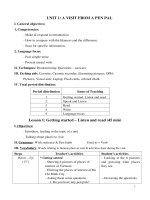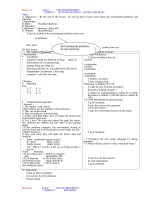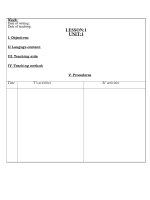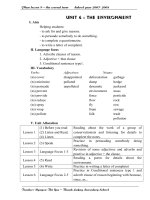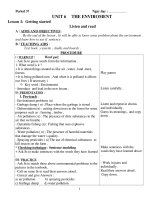Giao an anh 9 tinh Bac Giang
Bạn đang xem bản rút gọn của tài liệu. Xem và tải ngay bản đầy đủ của tài liệu tại đây (273.9 KB, 44 trang )
Teaching plan
Grade 9
School year: 2007-2008.
Week: 01. Date of making: 05/09/2007
Period: 01. Date of teaching: 08/09/2007
Unit 1: A visit from a pen pal
Lesson 1: Getting started, listen and read.
I) The aims:
1) Objectives:
- Helps students know some vocabulary.
- By the end of the lesson, students will be able to know some new words
activities they would do during the visit, understand (the content of the dialogue)
between Lan and Lan’s pen pal Manryam.
2) Teaching points: The past simple tense (wish) with wish.
3) Preparation: Teacher’s: Lesson plan, textbook, pictures, cues…..
Students': Textbook, notebook, and reference book.
II) Procedures:
1) Organization: (1-2’) - Good morning! Sit down, please!
- What’s the date today?
- Who’s absent today?
- How are you today?
2) Checking up and warm up (5-7’):
Questions Answers
* Put the words in bracket into correct form:
1. Lan (wash) the dishes for me yesterday.
2. I (buy) that dictionary last year.
3. Hoa (use) to walk to school on foot.
4. They (visit) Ho Chi Minh mausoleum two
days ago.
5. Last summer, my brother and I (go) to the
temple of Liter.
Let’s students do on paper and collect then
check.
* Net work:
Ha Long Bay
Hung temple
Sam Son beach
1. washed.
2. bought.
3. used.
4. visited.
5. went.
3) New lesson (30-35’):
1
Place of interest
Teachers activities T Sts activities
* Pre-teach:
- (to) impress /im'pres/: gây ấn tợng (Explanation).
- (to) pray /prei/ cầu nguyện (Mine).
- (to) correspond /kris'pnd/: trao đổi (Translation).
- (to) keep in touch with: liên lạc (Explanation).
- mosque [msk] (n): Nhà thờ Hồi giáo (Translation).
- (to) wish [wi]: ớc (Situation).
+ Check vocabulary: Rubout and remember.
* Matching:
- Asks students to match the pictures on P6 with the
places (Poster).
Keys: a, b, c, d, e, f.
Places:
1. Hai Van Pass.
2. A restaurant.
3. Hung temple.
4. The temple of literature.
5. Dong Xuan market.
6. A history building.
- Lets them work in pairs.
Keys: a.1; b. 4; c. 5; d.3; e.2; f.6.
+ What are these places famous for?
- Says something about the places.
* Presentation:
- Sets the scene: Em có một chuyến đi thăm quan em sẽ
làm gì?
A: What would you do during the visit?
B: I wish I could stay longer.
+ Concept check:
Form: What would + S + Vinf.?
S + would + Vinf..
S + wish/ wishes + (that) + S + could + Vinf..
Use: Ước muốn ở hiện tại.
* Practice: Word cues.
1. wish/ visit the temple of literature.
2. wish/ go to Huong pagoda.
3. wish/ see Hai Van Pass.
4. wish/ go Hung temple.
- Gives the pictures and asks them to give the wishes of
these people.
* Listen and read.
- Introduces the topic of the lesson: Reading about A
visit from the pen pal and situation of the text.
07
03
10
10
- Listen.
- Listen and repeat
individually, in
choral.
- Copy down.
- Match.
- Work in pairs.
- Answers.
- Listen.
- Listen and read.
- Copy down.
- Run through.
- Do the cues.
- Speak.
- Listen.
- Read.
2
- Asks students to look at the text to know where Lan
took Maryam.
- Asks students to listen to the tape 2-3 times.
- Asks them to do the exercise 2 P 11.
Keys: 1.C; 2. B; 3. D; 4. B.
- Listen.
- Work
individually.
4) Consolidation (2-3’):
- Play a role Lan and Maryam to tell the story.
5) Homework (1-2’):
- Ask students to learn by heart the lesson.
- Do the exercise 3 P12, 7 P10 exercise book.
- Prepare new lesson.
Week: 02. Date of making: 07/09/2007
Period: 02. Date of teaching: 12/09/2007
Unit 1: A visit from a pen pal
Lesson 2: Speak.
I) The aims:
1) Objectives:
- Helps students know some vocabulary.
- By the end of the lesson, students will be able to introduce themselves.
- They have a chance to speak with their friends.
2) Teaching points: Students develop speaking fluency and accuracy on the
topic of meeting friends.
3) Preparation: Teacher’s: Lesson plan, textbook, posters.
Students': Textbook, notebook, and reference book.
II) Procedures:
1) Organization: (1-2’) - Good morning! Sit down, please!
- What’s the date today?
- Who’s absent today?
- How are you today?
2) Checking up and warm up (5-7’):
Questions Answers
* Write the sentences beginning with “I wish…”.
a) It’s so hot. You want to be in the swimming
pool.
b) You don’t have a computer.
* Write new words.
- Calls students to do, correct and gives them
marks.
* Warmer: Word square.
-> I wish I were in the
swimming pool.
-> I wish I had a computer.
3
H I N D U I S M a
O M O S Q U E S Y
D P I W I S H I I
E R A S C N O H C
T E M P L E C D C
H S D R N A N D O
N S I A C C m U E
I O T Y O O H B M
C R E L I G I O n
-> wish, Hinduism, mosque,
temple, religion.
Islam.
Ethnic, pray, impress,
Buddhism.
3) New lesson (30-35’):
Teacher’s activities T Sts’ activities
* Pre-teach:
- (to) be different from: Kh¸c so víi (Translation).
- (to) be the same: gièng (Antonym).
- (to) introduce: giíi thiÖu (Example).
- Lets go: chóng ta h·y cïng ®i (Translation).
+ Check vocabulary: Rubout and remember.
* Pre-speaking (pre-questions).
1. What is Lan’s pen pal’s name?
2. What nationality is she?
3. Which city is she from?
4. How long have they been pen pals?
5. How often do they write?
- Asks students to work in pair.
* While-speaking:
a) Matching: Asks students to put the sentences in the
correct order to make the dialogue between Nga and
Maryam.
Keys: Nga: 1-5-4-2-3-6.
Maryam: c-b-d-e-a.
b) Practice:
- Asks students to practice the dialogue between Nga
and Maryam.
c) Asks students to work in groups of three to do role-
play of Yoko, Paul and Jane. Each introduces themselves
to the others.
Yoko/ Tokyo
Japan
Paul/ Liverpool
England
Jane/Perth
Australia.
* Post-speaking (Write it up).
- Asks students to write introduction of their two friends
06’
06’
10’
08’
- Listen.
- Listen and repeat
individually, in
choral.
- Copy down.
- Answer.
- Work in pair.
- Work in pair.
- Write it up.
4
using information in part b.
Eg: My friend is Yoko. She is from Tokyo, Japan. It’s a
busy big capital city. She likes VN people and loves old
cities in VN.
4) Consolidation (2-3’):
- What do you introduce yourselves about?
Name – age – hobbies – class – country.
5) Homework (1-2’):
- Ask students to learn by heart the lesson.
- Do the exercise 3 P6 VBT.
- Prepare new lesson.
Week: 02. Date of making: 10/09/2007
Period: 03. Date of teaching: 14/09/2007
Unit 1: A visit from a pen pal
Lesson 3: Listen.
I) The aims:
1) Objectives:
- Helps students know some vocabulary.
- By the end of the lesson, students will be able to listen for details.
- They have a chance to listen to the tape.
2) Teaching points: Listen and understand the text.
3) Preparation: Teacher’s: Lesson plan, tape, and cassette.
Students': Textbook, notebook, and reference book.
II) Procedures:
1) Organization: (1-2’) - Good morning! Sit down, please!
- What’s the date today?
- Who’s absent today?
- How are you today?
2) Checking up and warm up (5-7’):
Questions Answers
* Make the dialogue.
* Write the vocabulary.
- Teacher listens and check, gives them marks.
* Warmer:
Kim’s game: Look at the pictures on page 9.
Students close the books; list the pictures that
they can remember from the picture.
3) New lesson (30-35’):
Teacher’s activities T Sts’ activities
5
* Pre-teach:
- downtown: Khu b¸n bu«n (Explanation).
- It’s time we caught the bus: §Õn giê chóng ta b¾t xe
(Translation).
+ Check vocabulary: Rubout and remember.
* Listening:
- Asks students to work in pairs, look at the pictures and
discuss where are these pictures in? What are they
talking? And what activities are there?
T/F statement prediction.
1. Tim and Carlo are going to the countryside.
2. They are going there by car.
3. There is a park near Tim’s house.
4. They can walk in the grass.
5. They are going to have Mexican food.
* While-reading:
- Asks students to listen to the cassette between Tim and
Jane and Carlo then check their prediction.
Keys: 1. F; 2. F; 3. T; 4.F; 5. F.
- Listens and checks their answers.
Keys:
1. We can not walk on the grass A.
2. We want the bus number 130 B.
3. They are hungry and they want to have some
hamburger. B.
* Post-listening:
Write it up.
- Asks students to write a paragraph about what Tim and
Carlo did.
04’
08’
10’
08’
- Listen.
- Listen and repeat
individually, in
choral.
- Copy down.
- Work in pair.
- Listen and
check.
- Listen.
- Write.
4) Consolidation (2-3’):
- Retell the lesson.
5) Homework (1-2’):
- Ask students to learn by heart the lesson.
- Do the exercise 5 P8 VBT.
- Prepare new lesson.
Week: 03. Date of making: 15/09/2007
Period: 04. Date of teaching: 19/09/2007
Unit 1: A visit from a pen pal
Lesson 4: Read.
I) The aims:
6
1) Objectives:
- Helps students know some vocabulary.
- By the end of the lesson, students will be able to get some information about
Malaysia.
- They have a chance to read a text in English.
2) Teaching points: Read a passage on the topic of Malaysia.
3) Preparation: Teachers: Lesson plan, tape, cassette, map and poster.
Students': Textbook, notebook, and reference book.
II) Procedures:
1) Organization: (1-2) - Good morning! Sit down, please!
- Whats the date today?
- Whos absent today?
- How are you today?
2) Checking up and warm up (5-7):
Questions Answers
- Check the exercise part b, c in exercise 5 P8.
b) Lan used to travel a lot and visit many places of interest but now
she doesnt go away much.
c) Lan used to meet a lot of people but now she doesnt meet many
people.
* warmer: Hangman: 8 letters Malaysia.
3) New lesson (30-35):
Teachers activities T Sts activities
* Pre-teach:
- (to) be separated ['seprt] (adj) bị tách ra, phân biệt,
phân chia(Translation).
- tropical climate ['trpikl] ['klaimit]: khí hậu nhiệt đới
(Translation).
- population [,ppju'lein] (n): dân số (Explanation).
- compulsory [km'plsri] (adj): bắt buộc (Antonym).
- (to) comprise [km'praiz]: bao gồm, gồm có
(Translation).
- unit of currency ['krnsi] (n): đơn vị tiền tệ
(Explanation).
- optional ['pnl] (adj): lựa chọn (Antonym).
+ Check vocabulary: Rubout and remember.
* Pre-reading:
T/F Statement prediction.
a) Malaysia is smaller than Viet Nam.
b) The capital of Malaysia is Jakarta.
c) The unit of currency in Malaysia is Vietnam dong.
d) Education is free in Malaysia.
08
05
- Listen.
- Listen and repeat
individually, in
choral.
- Copy down.
- Work in groups.
- Work
individually.
7
e) Malaysia has Twins-Towers.
f) Malaysia is one of the countries of ASEAN.
- Gets feedback.
* While-reading:
- Asks students to read the text then check their
predictions.
Keys: a. T; e. T; f. T; b. F Kuala Lumpur; c. F Ringgit;
d. F compulsory.
- Turns on the cassette.
- Asks students to the exercise a (Fill in the table with
the right information about Malaysia).
Keys:
1. Area: 329758sq km.
2. Population: Over 22 million (2001).
3. Climate: Tropical climate.
4. Unit of currency: Ringgit.
5. Capital city: Kuala Lumpur.
6. Official religion: Islam.
7. National language: Bahasa Malaysia.
8. Compulsory second language: English.
- Asks students to do the exercise b.
Keys: 1T; 2F (There are 2 more than religions); 3F
(English, Chinese and Tamil are also widely spoken). 4F
(One of the three “Malaysia, China, and Tamil”. 5F
English is compulsory 2
nd
language, not primary
language of instruction, Bahasa Malaysia is the primary
language of……).
* Post –reading: (Deliberate Mistake).
- Asks students to listen the following text about
Malaysia. If they hear anything wrong. They shout the
word and give the correct one.
Malaysia is an Asian country. It has the population of 32
million people. The Malaysian capital is Chiang Mai.
There are 14 states in Malaysia. People speak
Vietnamese in Malaysia and education in optional, the
official religion is Buddhism.
12’
05’
- Read the text.
- Listen again the
text.
- Do the exercise.
- Do the exercise.
- Listen and check
wrong
information.
4) Consolidation (2-3’):
- Summarize the content of the text.
5) Homework (1-2’):
- Ask students to learn by heart the lesson, read the text again.
- Do the exercise III P9, 10.
- Prepare new lesson.
Week: 03. Date of making: 18/09/2007
8
Period: 05. Date of teaching: 21/09/2007
Unit 1: A visit from a pen pal
Lesson 5: Write
I) The aims:
1) Objectives:
- Helps students know some vocabulary.
- By the end of the lesson, students will be able to know how to write an
informal letter to a pen pal.
- They have a chance to write a letter.
2) Teaching points: Write an informal letter to a pen pal.
3) Preparation: Teacher’s: Lesson plan, and poster.
Students': Textbook, notebook, and reference book.
II) Procedures:
1) Organization: (1-2’) - Good morning! Sit down, please!
- What’s the date today?
- Who’s absent today?
- How are you today?
2) Checking up and warm up (5-7’):
Questions Answers
* Write the vocabulary in last period.
ASEAN: Association of South East Asian Nations.
* Warm up: Jumped words.
- Asks students to guess the name of the sections of a letter.
Ngiopne: = Opening. Dody: = Body.
Ngisolc: = Closing. Tertel: = Letter.
- Checks and gives the right answers.
3) New lesson (30-35’):
Teacher’s activities T Sts’ activities
* Pre-teach:
- outline ['autlain] (n): dµn bµi (Explanation).
- paragraph ['pærəgrɑ:f] (n): ®o¹n v¨n (Translation).
- (to) mention ['men∫n]: ®Ò cËp, kÓ ra (Explanation).
+ Check vocabulary: What and Where.
* Pre-writing: (Matching).
- Asks students to match a part in A with a part in B.
A B
Opening 1. Dear. 5. Yours.
Body 2. 1
st
paragraph. 6. Date.
Closing 3. Love. 7. 2
nd
paragraph.
4. 3
rd
paragraph
04’
05’
- Listen.
- Listen and repeat
individually, in
choral.
- Copy down.
- Match.
- Give the answer.
9
- Gets feedback.
Opening: 6, 1.
Body: 2, 7, 4.
Closing: 3, 5.
* While-writing:
Now imagine you are visiting one of your relatives or
friends in another part of Viet Nam or in different
countries, write a letter to your family using the outline
in P11.
- Asks students to read the outline carefully.
- Divides the class into small groups.
* Suggested writing:
Hai Phong Thursday 26
th
June.
Dear Mum.
I arrived at HP bus station at 6 pm on Saturday evening.
Long, Ha and aunt Hoa met me at Tam Bac bus station
and took me home by motorbike. After dinner, Long, Ha
and I walk around and drank tea in a restaurant near the
city center; Hai Phong is a very busy and beautiful at
night.
I’ve been to several places in Hai Phong such as Cat Ba
Islands, Sat Market…. I’ve tried a lot of seafood and
specialties. We’ll go to Do Son beach tomorrow.
Mom I’d like to stay here longer. I enjoy everything
here. I’ll leave Hai Phong on Monday. Please pick me up
at the bus station at 7 pm.
Bye Mom, I miss you.
Your son.
Hong Son.
* Post-writing:
- Asks students to exchange the writing task and correct
if possible.
- Calls out one or two group read their writing.
13’
08’
- Write a letter.
- Share and
comparing their
writing.
4) Consolidation (2-3’):
- What have you learnt about today?
5) Homework (1-2’):
- Ask students to learn by heart the lesson.
- Write and complete the letter.
- Prepare new lesson.
Week: 04. Date of making: 20/09/2007
Period: 06. Date of teaching: 26/09/2007
10
Unit 1: A visit from a pen pal
Lesson 6: Language focus.
I) The aims:
1) Objectives:
- Helps students know some vocabulary.
- By the end of the lesson, students will be able to do some kinds of exercises.
- They have a chance to do exercises.
2) Teaching points: Past simple.
3) Preparation: Teacher’s: Lesson plan, English book, pictures, posters.
Students': Textbook, notebook, and reference book.
II) Procedures:
1) Organization: (1-2’) - Good morning! Sit down, please!
- What’s the date today?
- Who’s absent today?
- How are you today?
2) Checking up and warm up (5-7’):
Questions Answers
* Asks one students to read the letter that they have completed at
home.
* Revision: Palmanism.
Buy Make Go Hang Paint
A cake Flowers A picture Color lamps Shopping
- Corrects and gives them marks.
3) New lesson (30-35’):
Teacher’s activities T Sts’ activities
* Pre-teach:
- ghost [goust] (n): ma (Explanation).
- monster ['mɔnstə] (n): qu¸i vËt (Explanation).
- height [hait] (n): chiÒu cao (Visual).
- association [ə,sousi'ei∫n] (n): hiÖp héi (Translation).
+ Check vocabulary: Matching.
* Mapped dialogue:
Dung
What…Ba…on the weekend?
When…?
Nga….?
When…?
Lan….?
When…..?
Diu
Ghost and monster.
Saturday 2 pm.
Center-HN - singers.
Saturday 8 pm.
Camp…Y&Y.
All weekends.
- Lets students practice.
* Introduces the situation of exercise 2.
- Asks students to look at the picture and word given.
05’
08’
08
- Listen.
- Listen and repeat
individually, in
choral.
- Copy down.
- Work in pairs.
- Work
individually.
11
- Give the names for people in the numbered circles.
Eg: 1. Hoa, 2. Ha…
P1: Hoa made a cake.
P2: Ha hung the color lamps on the walls.
- Asks students to work in pairs, call them read the
sentences and other follow and remark.
Keys:
P3: Lan and Hong bought flowers and put them in the
vases.
P4: Hung painted a picture of Ha Noi.
P5: Ba and Thai went shopping.
* Team work: Noughts and Crosses.
- Asks students to do the exercise 3 P12 by playing
Noughts and Crosses.
a b c
d e f
g h i
- Asks students to write their wishes in their notebook (at
home).
09’
- Work
individually.
- Work in group.
- Write (at home).
4) Consolidation (2-3’):
- Retell the lesson.
5) Homework (1-2’):
- Ask students to learn by heart the past simple tense.
- Do exercise 1, 2, 3 again and do the exercise 4 P7 in exercise book.
- Prepare new lesson.
Week: 04. Date of making: 25/09/2007
Period: 07. Date of teaching: 29/09/2007
Unit 2: clothing.
Lesson 1: Getting started, Listen and read.
I) The aims:
1) Objectives:
- Helps students know some vocabulary.
- By the end of the lesson, students will be able to know some traditional
clothes in Viet Nam and other countries.
- They have a chance to listen and read the text in English.
2) Teaching points: The present perfect tense.
3) Preparation: Teacher’s: Lesson plan, English book, pictures, word cues
and cassette.
Students': Textbook, notebook, and reference book.
II) Procedures:
1) Organization: (1-2’) - Good morning! Sit down, please!
12
- Whats the date today?
- Whos absent today?
- How are you today?
2) Checking up and warm up (5-7):
Questions Answers
* Teacher reads the words in Vietnamese and students have to write
them in English.
1. Khí hậu Tropical climate.
2. hiệp hội Association
3. đoạn văn Paragraph
4. dân số Population
5. giới thiệu Population
Sentences: Tôi ớc muốn có một chiếc máy vi tính.
I wish I had a computer.
- Teacher corrects and gives them marks.
* Hangman: CLOTHING (8 letters).
3) New lesson (30-35):
Teachers activities T Sts activities
* Pre-teach:
- (to) design: [di'zain] thiết kế (Translation).
- poem ['pouim] (n): bài thơ (Explanation).
- inspiration [,insp'rein] (n): nguồn cảm hứng
(Translation).
- unique [ju:'ni:k] (adj): độc đáo, có 1 không 2
(Explanation).
- symbol ['simbl] (n): biểu tợng (Example).
- ethnic minority ['enik mai'nriti] (n): dân tộc thiểu số
(Example).
- a long silk tunic ['tju:nik] (n): tà áo dài (Translation).
+ Check vocabulary: Rubout and remember.
* Getting started:
- Asks students to look at the picture on P 14 and the
picture with the names of the clothes.
A kimono, ao dai, jeans, a veil, a sari.
Pa: Kimono Pd: a sari Pf: a veil
Pb: Ao dai Pe: Jeans
- Asks students to match the picture with the countries
where these people come from P a, b, c, d, e, f.
1. Viet Nam 2. Scotland 3. The USA
4. Arabia Saudi 5. Indian 6. Japan.
* Listen and read.
- Writers and musicians have mentioned the centuries ao
08
05
17
- Listen.
- Listen and repeat
individually, in
choral.
- Copy down.
- Match.
- Match.
13
dai in novels and song for countries.
+ Concept check:
Form: S + have/ has + PII.
Use: Diễn tả hành động đã xảy ra trong quá khứ kết quả
còn liên quan đến hiện tại.
* Practice: Word cues.
1. Designers/ take/ inspiration.
2. They/ visit/ villages.
3. We/ study English/ 4 years.
4. They/ study/ traditional design.
- Asks students to listen to the text after reading and
doing activities their checks.
* Complete the sentences.
1. poem, songs and novels.
2. traditional dress of Vietnamese women.
3. to wear modern clothing at work.
4. lines of poetry on it.
5. traditional designs and symbols like suns.
- Asks students to work in pairs to answer the questions:
Keys:
1. By tradition men and women used to wear the ao dai.
2. Because its more convenient.
3. to modernize the ao dai, fashion designers have
printed lines of poetry on it and they have added
traditional designs and symbols like suns, stars,
crosses and stripes to Velvet.
- Run through.
- Do the exercise.
- Work in pairs to
answer the
questions
4) Consolidation (2-3):
- Retell the lesson.
5) Homework (1-2):
- Ask students to learn by heart the past simple tense.
- To sum up traditional ao dai.
- Answers the questions: Do you like the ao dai? Why (not)?
- Prepare new lesson.
Week: 05. Date of making: 29/09/2007
Period: 08. Date of teaching: 03/10/2007
Unit 2: clothing.
Lesson 2: Speak.
I) The aims:
1) Objectives:
- Helps students know some vocabulary.
14
- By the end of the lesson, students will be able to speak about the topic of
clothes.
- They have a chance to speak with their friends.
2) Teaching points: Speak about the topic of clothes.
3) Preparation: Teacher’s: Lesson plan, English book, pictures and posters.
Students': Textbook, notebook, and reference book.
II) Procedures:
1) Organization: (1-2’) - Good morning! Sit down, please!
- What’s the date today?
- Who’s absent today?
- How are you today?
2) Checking up and warm up (5-7’):
Questions Answers
- Write the vocabulary in last period.
- Read the content of the traditional ao dai.
Checks and gives them marks
* Warm up: Guessing game.
Teacher describes some students’ clothes and the class guess who
they are.
3) New lesson (30-35’):
Teacher’s activities T Sts’ activities
* Pre-teach:
- short sleeved ['sli:vid] (adj): (Visual).
- baggy pants ['bægi] [pænts] (n): (Explanation).
- faded jeans ['feid] (n): (Visual).
- striped shirt ['straipt] (n): (Explanation).
- plaid skirt [plæd] (n): (Translation).
- sleeveless sweeter ['sli:vlis] (n): (Explanation).
+ Check vocabulary: Matching.
- Asks students to match the numbered phrases to the
pictures in exercise a P14.
Keys:
a) a color T shirt. f) a short-sleeved blouse.
b) a sleeveless sweater. g) baggy pants.
c) a striped shirt. h) a plaid skirt.
d) a plain suit. i) blue short.
e) faded jeans
* Pre-speaking (Pre-questions).
- Hangs the poster on blackboard and asks students to
think about the answers.
Do you wear school uniform everyday?
What color clothes do you like best?
08’
07’
- Listen.
- Listen and repeat
individually, in
choral.
- Copy down.
- Match.
- Answer the
question.
15
Do girls like wearing skirt to school?
What do you wear at parties or on holiday?
Do you like wear shoes or sandals?
- Gets feedback.
* While-speaking:
- Asks students to work in group of 4 to interview each
other about students’ clothing and write them down in
the columns. The information in the box on P 15 can
help. Students can make 2 more questions for clothes for
special occasions.
Questions: What type of clothing do you wear at Tet/ on
holiday?
What would you wear to a party?
Survey:
Name Casual
clothes
Favorite
clothes
School
uniform
Clothes
for
special
occasion
Lan A short
sleeved
blouse/
baggy pants
– cool
comfortable
Short
baggy
pants and
short
sleeved
blouse
Wear it
everyday
except for
Sunday
compulsory
dark, blue
and white
Jeans and
blouse (a
long
sleeved
blouse –
look
stronger
in these
clothes.
- After that asks students to talk about what their friends
wear.
Eg: Lan usually wears a short-sleeved blouse and baggy
pants.
* Post-speaking (Write it up):
- Asks students to write a report using the results of the
survey.
Eg: Lan said that she liked short baggy pants and short-
sleeved blouse.
10’
05’
- Work in group.
- Work
individually.
- Write.
4) Consolidation (2-3’):
- Retell the lesson.
5) Homework (1-2’):
- Ask students to learn by heart the lesson
- Prepare new lesson.
Week: 05. Date of making: 02/10/2007
16
Period: 09. Date of teaching: 05/10/2007
Unit 2: clothing.
Lesson 3: Listen.
I) The aims:
1) Objectives:
- Helps students know some vocabulary.
- By the end of the lesson, students will be able to listen and describe or realize
someone through his/ her clothes/ shoes.
- They have a chance to listen the tape in English.
2) Teaching points: Listen a conversation about clothes.
3) Preparation: Teacher’s: Lesson plan, English book, cassette and posters.
Students': Textbook, notebook, and reference book.
II) Procedures:
1) Organization: (1-2’) - Good morning! Sit down, please!
- What’s the date today?
- Who’s absent today?
- How are you today?
2) Checking up and warm up (5-7’):
Questions Answers
* Write the vocabulary in last period.
* Write a report sentences using the results of the survey.
* Warm up:
- Asks students to name as many kinds of clothes as possible.
Dress
T-shirt.
Skirt
Scarf
Shirts
Trousers
Socks
Tights
Shorts
Jeans
3) New lesson (30-35’):
Teacher’s activities T Sts’ activities
* Pre-teach:
- Main entrance ['entrəns] (n): con ®êng chÝnh
(Translation).
- car fair [feə](n): Héi trî triÓn l·m « t« (Explanation).
- missing ['misiη] (n): sù l¹c ®êng (Explanation).
- (to) announce [ə'nauns]: th«ng b¸o (Mine).
Announcement: sù th«ng b¸o.
07’
- Listen.
- Listen and
repeat.
- Read in choral
and individually.
- Copy down.
17
Clothes
